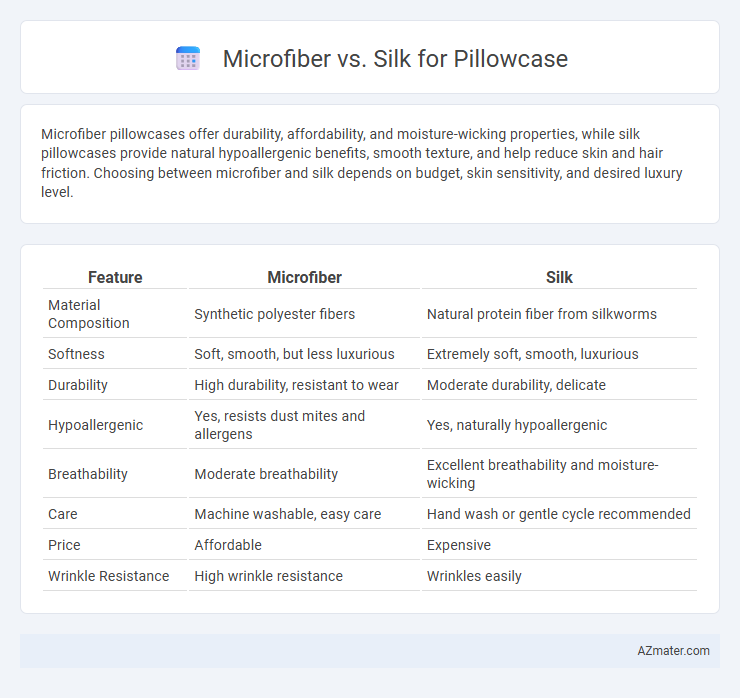Microfiber pillowcases offer durability, affordability, and moisture-wicking properties, while silk pillowcases provide natural hypoallergenic benefits, smooth texture, and help reduce skin and hair friction. Choosing between microfiber and silk depends on budget, skin sensitivity, and desired luxury level.
Table of Comparison
| Feature | Microfiber | Silk |
|---|---|---|
| Material Composition | Synthetic polyester fibers | Natural protein fiber from silkworms |
| Softness | Soft, smooth, but less luxurious | Extremely soft, smooth, luxurious |
| Durability | High durability, resistant to wear | Moderate durability, delicate |
| Hypoallergenic | Yes, resists dust mites and allergens | Yes, naturally hypoallergenic |
| Breathability | Moderate breathability | Excellent breathability and moisture-wicking |
| Care | Machine washable, easy care | Hand wash or gentle cycle recommended |
| Price | Affordable | Expensive |
| Wrinkle Resistance | High wrinkle resistance | Wrinkles easily |
Introduction: Microfiber vs Silk Pillowcases
Microfiber pillowcases offer durability, affordability, and resistance to wrinkles and stains, making them a popular choice for everyday use. Silk pillowcases provide natural hypoallergenic properties, superior smoothness, and moisture retention, benefiting skin and hair health. Choosing between microfiber and silk depends on prioritizing budget-friendly practicality or luxury skincare benefits.
Material Composition: Microfiber and Silk Compared
Microfiber pillowcases are composed of finely woven synthetic fibers, typically polyester, known for their durability, wrinkle resistance, and affordability. In contrast, silk pillowcases are made from natural protein fibers produced by silkworms, prized for their smooth texture, breathability, and hypoallergenic properties. The fundamental difference in material composition affects moisture retention, temperature regulation, and skin health benefits, with silk offering superior softness and moisture-wicking qualities compared to the synthetic yet easy-care nature of microfiber.
Comfort and Softness: Which Feels Better?
Silk pillowcases offer unparalleled softness due to their natural protein fibers, providing a smooth and luxurious feel that reduces friction on the skin and hair. Microfiber pillowcases, made from synthetic fibers like polyester, deliver a soft texture but often lack the breathability and gentle glide of silk. For those prioritizing comfort and a soothing touch, silk is typically favored over microfiber for its superior softness and hypoallergenic properties.
Skin Benefits: Reducing Wrinkles and Acne
Silk pillowcases are renowned for their natural hypoallergenic properties and smooth texture, which reduce friction on the skin, thereby minimizing wrinkle formation and preventing acne caused by irritation. Microfiber pillowcases, while soft and affordable, tend to retain oils and bacteria, potentially exacerbating acne and offering less protection against skin creases. Choosing silk over microfiber enhances skin hydration and promotes a clearer, smoother complexion by reducing inflammation and skin stress during sleep.
Hair Health: Frizz Control and Breakage Prevention
Microfiber pillowcases offer friction reduction that helps minimize hair frizz and breakage by providing a smoother surface compared to cotton. Silk pillowcases excel in maintaining hair moisture, reducing static and tangling, which further prevents split ends and hair damage during sleep. Both materials contribute to improved hair health, but silk's natural protein structure better supports frizz control and breakage prevention for delicate or chemically treated hair.
Breathability and Temperature Regulation
Microfiber pillowcases offer moderate breathability due to their tightly woven synthetic fibers, which can trap heat and moisture, making them less ideal for those who overheat at night. Silk pillowcases excel in temperature regulation with natural protein fibers that wick moisture away and allow better airflow, promoting a cooler and more comfortable sleep environment. The inherent breathability of silk helps maintain an optimal skin temperature, reducing night sweats and enhancing overall sleep quality.
Durability and Longevity: Which Lasts Longer?
Microfiber pillowcases offer superior durability due to their tightly woven synthetic fibers, resisting wear and tear, shrinking, and fading over extended use. Silk pillowcases, while luxurious and gentle on the skin, are more delicate and prone to damage from frequent washing or rough handling, often requiring careful maintenance to maintain their longevity. Overall, microfiber lasts longer under regular use and washing conditions, making it a more resilient choice for long-term pillowcase durability.
Ease of Care: Washing and Maintenance
Microfiber pillowcases are highly durable and can be machine washed using warm water, drying quickly without requiring special care, making them ideal for everyday convenience. Silk pillowcases demand gentle care, typically requiring hand washing or a delicate cycle with mild detergent to maintain their natural fibers and smooth texture. While microfiber is more resistant to wrinkles and stains, silk needs careful handling to avoid damage, making microfiber a practical choice for easy maintenance.
Price Comparison: Affordable vs Luxury
Microfiber pillowcases typically cost between $10 and $25, making them an affordable choice for budget-conscious consumers seeking soft, durable fabric. Silk pillowcases range from $50 to $150 or more, reflecting their luxury status and benefits like hypoallergenic properties and smooth texture that reduces hair frizz. The price gap highlights microfiber as a cost-effective option, while silk represents a premium investment in sleep quality and skin care.
Eco-Friendliness and Sustainability
Microfiber pillowcases, made from synthetic fibers like polyester, often rely on non-renewable petroleum sources and contribute to microplastic pollution during washing, raising eco-friendliness concerns. Silk pillowcases, derived from natural silk produced by silkworms, are biodegradable and renewable but involve energy-intensive farming and ethical questions regarding silkworm treatment. Choosing sustainable bedding involves weighing microfiber's durability against silk's biodegradability, factoring in manufacturing processes and the environmental impact of production and disposal.

Infographic: Microfiber vs Silk for Pillowcase
 azmater.com
azmater.com